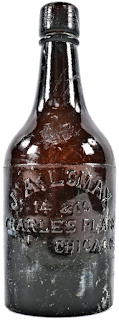After the fire, the family was decimated financially and their reputation was shot. They moved to the South Side Back of the Yards neighborhood where Jim grew up. O'Leary worked for the local bookies when he was a teenager, and eventually, he began as a bookmaker himself in Long Beach, Indiana, an off-track betting resort. However, he soon went bankrupt and went to work at the Union Stock Yards, where he gained the nickname "Big Jim."
 |
| O'Leary's Saloon with neighboring buildings at 4183 South Halsted, Chicago. 1906 |
Note: Although Chicago renamed these streets; Dyer St., Egyptian Rd., 1st St., and 1st Ave., were renamed to Halsted in 1909, just not as far as 4100 south.
The renumbering of Chicago street addresses in 1909 for South Halsted, ends at 965 which was changed to today's address of 2338 South Halsted. North Halsted numbering changes stoped at 2040 which was changed to today's address of 3809 North Halsted.He also posted detailed race track results and other betting information near the entrance to the Stock Yards. O'Leary soon began operating a pool hall and book parlor in the rear of his saloon. He became one of the leading gamblers in Chicago and was known for taking bets on everything from presidential candidates to changes in the weather.
O'Leary had a reputation for fair dealing. Chicago's longtime alderman-vice lord, Michael “Hinky Dink” Kenna, said of him, "He was a square shooter. Big Jim never welshed on a bet. He was a good loser and his patrons had confidence in him that he would always pay off if he lost.
In 1904, O'Leary began operating illegal gambling on Lake Michigan aboard the steamship The City of Traverse. Without police protection, this ventured had failed by 1907 because of police raids each time the ship docked.
 |
| The steamship "City of Traverse" docked on the Chicago River. Related to Big Jim O'Leary's gambling raids on the "City of Traverse" ship. 1905 |
 |
| Big Jim O'Leary |
In 1906, Mayor Edward Fitzsimmons Dunne briefly revoked O'Leary's saloon license, but before long, O'Leary "sold" his gambling house to an employee, who reapplied for, and was granted, a new license, putting Big Jim back in business for good. Some of O'Leary's success in evading the police was political: his son, James, Jr., married the daughter of the city's top police inspector. Also, police officers, like most other men, enjoyed gambling and frequently tipped off O'Leary if a raid was planned.
A larger problem than the police were rival gamblers. During the gambling wars, Big Jim's place was bombed with dynamite in 1907 (possibly as retribution for the bombing two months earlier at Blind John Condon's place), and twice in 1908. Each time, he rebuilt.
Following Chicago crime lord Michael Cassius MacDonald's death that year O'Leary took over complete control of gambling on Chicago's southwest side around the Union Stock Yards.
In 1906, a group of investors, led by boxing promoter James "Big Jim" O'Leary announced plans to convert the ten-acre picnic grove into an amusement park at Halsted and 52nd Street, Chicago. Named Luna Park, the amusement park occupied the site of a former picnic grove owned by Joseph Oswald and commonly known as Oswald's Grove. It opened with O'Leary as the principal owner in 1907. In 1913, he opened the O'Leary Market on the former site of Luna Park.
"There are three kinds of people in this world; gamblers, burglars, and beggars. Nearly everybody gambles. Sometimes it's with money, sometimes it's with time, sometimes it's with jobs. Nearly every fellow is willing to take a chance. Other folks are burglars. They make their lives by stealing. The second-story man, the safecracker, and the dip are not the only burglars. You'll find a lot of others in offices in the loop. A fellow that won't gamble or steal is a beggar."O'Leary, who delivered whiskey to Colosimo's Cafe under an arrangement with Johnny Torrio, was suspected of involvement in the May 11, 1920 murder of James Colosimo, but no charges were brought against him. By the time of Colosimo's death, O'Leary had become a millionaire several times over.
Despite numerous raids by police, O'Leary was found guilty of gambling only one time during his thirty-year career. The perception was that O'Leary, along with gambling bosses Mont Tennes and "Hot Stove" Jimmy Quinn, controlled the Chicago Police.
O'Leary married Annie McLaughlin, whose family lived next to the O'Leary's at the time of the fire. They were the parents of two sons and three daughters.
Late in life, O'Leary mused to a reporter about his success: "How much have I cleaned up? I'm satisfied with the results. I've got enough to take a trip around the world when I sell my shop. Then I'm going to settle down in some live little town."
Big Jim never got to do that, as he died of natural causes at the age of 56 in his home at 726 West Garfield Boulevard, on January 23, 1925. Big Jim O’Leary knew you had to keep up a good front. When Jim died his entire estate was valued at $10,200.
After his death, the O'Leary gambling house continued to be run by a business partner for a few years, until, somewhat ironically, the place burned down in the second-biggest fire in Chicago history, the 1934 Stockyards fire. Jim and his wife are buried next to his parents in a Chicago cemetery.
Compiled by Dr. Neil Gale, Ph.D.



















































